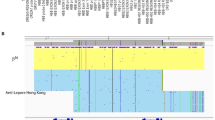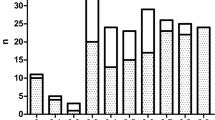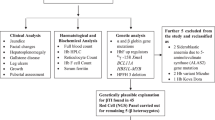Abstract
Haemoglobin E (α2β226GlU→Lys) is one of the commonest haemoglobin variants. There are an estimated 30 million carriers of the βE gene in South-East Asia, where they comprise more than 50% of the population in some areas1,2; however, the reasons for this high frequency have never been adequately explained. Homozygotes for HbE may be mildly anaemic, but they do not have any clinical disability3,4. However, individuals heterozygous for both βE and β thalassaemia (HbE/β thalassaemia) have a severe clinical disorder which in some cases may approach that seen in homozygous β thalassaemia3,5,6 and which is by far the commonest form of symptomatic thalassaemia in the Indian subcontinent and South-East Asia. Haemoglobin E is the only common structural variant which interacts with β thalassaemia to produce such a severe disorder and the underlying mechanism of the interaction is not known. We have studied several homozygotes and heterozygotes for HbE and show here that the βE chain is inefficiently synthesized and produces the phenotype of a mild form of β thalassaemia; hence, when inherited together with β thalassaemia it causes a marked β-chain deficit. Furthermore, the mechanism for the defective production of βE chains seems to be a reduction of βE mRNA, a most unexpected finding in a disorder caused by a single amino acid substitution and presumably by a single nucleotide change in the DNA of the β globin gene.
This is a preview of subscription content, access via your institution
Access options
Subscribe to this journal
Receive 51 print issues and online access
$199.00 per year
only $3.90 per issue
Buy this article
- Purchase on Springer Link
- Instant access to full article PDF
Prices may be subject to local taxes which are calculated during checkout
Similar content being viewed by others
References
Flatz, G. Humangenetik 3, 189–234 (1967).
Sicard, D., Lieurzou, Y., Lapoumeroulie, C. & Labie, D. Hum. Genet. 50, 327–336 (1979).
Chernoff, A. I. et al. J. Lab. clin. Med. 47, 455–489 (1956).
Fairbanks, V. F., Oliveros, R., Brandabur, J. H., Willis, R. R. & Fiester, R. F. Am. J. Hemat. 8, 109–121 (1980).
Bamapravati, N., Na-Nakorn, S., Wasi, P. & Tuchinda, S. Am. J. clin. Path. 47, 745–753 (1967).
Wasi, P. et al. Ann. N.Y. Acad. Sci. 165, 60–82 (1969).
Frischer, H. & Bowman, J. J. Lab. clin. Med. 85, 531–538 (1975).
Higgs, D. R. et al. Lancet ii, 272–276 (1979).
Fairbanks, V. F., Gilchrist, G. S., Brimhall, B., Jereb, J. A. & Goldston, E. C. Blood 53, 109–115 (1979).
Nute, P. E. Ann. N.Y. Acad. Sci. 241, 39–60 (1974).
Weatherall, D. J., Clegg, J. B., Na-Nakorn, S. & Wasi, P. Br. J. Haemat. 16, 251–267 (1969).
Wood, W. G. & Stamtoyannopoulos, G. J. clin. Invest. 55, 567–578 (1975).
Chalevalakis, G., Clegg, J. B. & Weatherall, D. J. Proc. natn. Acad. Sci. U.S.A. 72, 3835–3857 (1975).
Hunt, D. M. et al. Br. J. Haemat. 45, 53–64 (1980).
Feldman, R. & Rieder, R. F. Blood 42, 783–791 (1973).
Pagnier, J., Wajcman, H. & Labie, D. FEBS Lett. 45, 252–255 (1974).
Testa, U. et al. Acta haemat. 64, 42–52 (1980).
Berman et al. Clin. Res. 28, 350A (1980).
Author information
Authors and Affiliations
Rights and permissions
About this article
Cite this article
Traeger, J., Wood, W., Clegg, J. et al. Defective synthesis of HbE is due to reduced levels of βE mRNA. Nature 288, 497–499 (1980). https://doi.org/10.1038/288497a0
Received:
Accepted:
Issue Date:
DOI: https://doi.org/10.1038/288497a0
This article is cited by
-
HbE Level and Red Cell Parameters in Heterozygous HbE With and Without α0-Thalassemia Trait
Indian Journal of Hematology and Blood Transfusion (2018)
-
Genetic modifiers of Hb E/β0 thalassemia identified by a two-stage genome-wide association study
BMC Medical Genetics (2010)
-
Strong linkage disequilibrium of a HbE variant with the (AT)9(T)5 repeat in the BP1 binding site upstream of the β-globin gene in the Thai population
Journal of Human Genetics (2005)
-
Heterogeneity of mRNA expression in Italian fucosidosis patients
Human Genetics (1989)
-
Thalassaemia
Nature (1983)
Comments
By submitting a comment you agree to abide by our Terms and Community Guidelines. If you find something abusive or that does not comply with our terms or guidelines please flag it as inappropriate.



